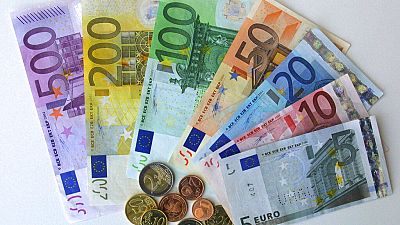Real minimum wages fell in most EU member states as inflation reached its highest levels. Where in Europe is feeling this the most?
In 2022, inflation rates rocked the EU, reaching levels not seen before in the previous four decades.
Low-income households are struggling to cope with the resulting cost-of-living crisis. Almost all EU member states have increased the minimum wage in the last two years, but rising inflation has led to a decline in real wages.
The OECD calls for regular revisions to protect the standard of living of low-paid workers.
In the EU, the annual inflation rate was 11.5 per cent in October 2022, up from 4.4 per cent a year earlier. Between 1997 and late 2021, the highest annual inflation was only 4.4 percent as recorded in July 2008.
This dramatic increase in inflation is disproportionally hitting the most vulnerable low-income households.
Minimum wages have recently risen in many EU countries, but that increase has been in nominal terms. In other words, inflation is not taken into account.
As of September 2022, the real minimum wage – or the wage reflecting the impact of inflation – had decreased in many EU countries over the last year.
Annual inflation rate in the EU (January 1997-October 2022)
Highest and lowest minimum wages in the EU
In July 2022, the monthly gross minimum wage in EU member states ranged from €363 in Bulgaria to €2,313 in Luxembourg. There are six countries with a minimum wage above €1,500. They are Luxembourg, Belgium (€1,842), Ireland (€1,775), the Netherlands (€1,756), Germany (€1,744), and France (€1,646).
Gross monthly minimum wages (July 2022)
Minimum wage is under €1,000 in 13 of 21 EU member states
A national minimum wage exists in 21 of the 27 EU member states. Denmark, Italy, Cyprus, Austria, Finland, and Sweden do not have a minimum wage. In 13 of 21 EU countries, the monthly gross minimum wage is below €1,000. In 10 of these, it is less than €750.
Among candidate and potential candidate countries, it ranges from €269 in Albania to €532 in Montenegro.
Variations are smaller considering purchasing power standard (PPS)
Variations in minimum wages are significantly smaller when we consider the values in purchasing power standard (PPS).
PPS is “an artificial currency unit” defined by Eurostat and based on price level differences between countries. One unit of PPS can theoretically buy the same amount of goods and services in each country.
The difference between the lowest and highest nominal minimum wage in the EU is 6.4 times in terms of PPS and the ratio is 2.8.
Gross monthly minimum wage in purchasing power standard (PPS), (July 2022)
The minimum wage as adjusted for PPS ranged from €630 in Latvia to €1,748 in Luxembourg in 2022. It was also above €1,500 in Belgium, Germany, and the Netherlands.
Inflation impacts real minimum wage
As of September 2022, real minimum wages had declined in most of Europe over the last year. Looking at 19 countries (17 EU member states, the UK, and Turkey), the real minimum wage had increased only in Turkey (15.9 per cent), France (2.3 per cent), and Belgium (1.9 per cent) compared to figures for September 2021.
According to the OECD, statistical methodology may have an impact on the reported annual changes in real minimum wages in France and Belgium as minimum wages are indexed differently in these countries.
Annual change in real minimum wages (September 2022)
Real minimum wages fell in all other 16 countries in the last year. The highest decline occurred in Latvia at 18.2 per cent. In most countries, the annual decrease was more than 5 per cent.
Trends in real minimum wage
Looking at trends in the real minimum wage over a longer period, the fluctuations in some countries are remarkable.
Assuming the minimum wage was equivalent to 100 points in all countries in December 2020, the animated chart below clearly shows how it changed every month through September 2022.
When annual inflation in the EU was 5.6 per cent in January 2022, there was an increase in the minimum wage in 10 of 19 countries.
This fell to seven countries in April 2022 and only four in September 2022: Turkey, France, Belgium, and Slovenia. Except for Turkey, the increases were very slight.
Real minimum wages (December 2020 = 100 points)
All EU member states, the UK, and Turkey raised their minimum wages between January 2021 and September 2022, but changes in real minimum wages reveal that these increases often fell short of the impact of inflation.
Minimum wages in September 2022 (December 2020 = 100 points)
The case of Turkey is interesting as the real minimum wage has increased by 24.6 per cent since December 2020.
The Turkish government usually raises the minimum wage once a year, every January. However, it considerably increased the minimum wage in July 2022 as annual inflation had reached 79 per cent in June.
Looking at minimum wages in both nominal and real terms shows how they change in different directions in different countries.
In the example provided below, the nominal minimum wage increased in all four considered countries, but the real minimum wage rose only in France. It declined in Germany, the UK, and the Netherlands.
Minimum wages in nominal and real terms
OECD calls for regular revisions
Stefano Scarpetta, Director for Employment, Labour and Social Affairs at the OECD, called for regular revision of minimum wages.
"Real minimum wages have dropped in the vast majority of OECD countries as the cost-of-living crisis continues. Especially in times of high inflation, minimum wages need to be regularly revised to ensure that they maintain their usefulness," he stated on social media.
An OECD report titled ‘Minimum wages in times of rising inflation’ underlined that the cost-of-living crisis, which particularly affects workers at the bottom of the wage distribution, makes statutory minimum wages all the more important to protect the standard of living of low-paid workers.
"It is important that statutory minimum wages adjust regularly," the report emphasised.



